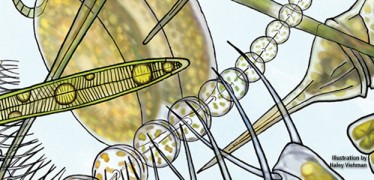 The University of Maine is working with four other research institutions in the region on a $1.1 million study to better understand the physical and biological processes that control the abundance of a plankton species that’s essential to the food web of the Northeast coastal ocean.
The University of Maine is working with four other research institutions in the region on a $1.1 million study to better understand the physical and biological processes that control the abundance of a plankton species that’s essential to the food web of the Northeast coastal ocean.
The researchers will study the marine copepod Calanus finmarchicus. About the size of a grain of rice, the planktonic animal is the primary prey for herring and other forage fish, as well as for the endangered North Atlantic right whale.
According to the researchers, rapid warming of the ocean surface in the Gulf of Maine in recent years has raised concern about potential effects on the coastal marine ecosystem, including C. finmarchicus, a subarctic species at the southern edge of its range.
The study will examine whether the transport of C. finmarchicus into the Gulf of Maine from cold Canadian waters, in combination with growth and reproduction in the relatively cold Maine Coastal Current, is sufficient to supply the region with the numbers needed to attract and nourish the animals that rely on the creature, despite recent ocean warming.
Jeffrey Runge, a professor in the School of Marine Sciences at UMaine, will serve as project coordinator/principal investigator and is responsible for biological measurements throughout the study.
“Changes in temperature, timing of the spring bloom and circulation in the Gulf of Maine will likely affect the distribution and abundance of C. finmarchicus in the Gulf of Maine, but not necessarily cause it to disappear,” says Runge, who has a joint appointment at the Gulf of Maine Research Institute in Portland.
The three-year study is a collaborative research project between UMaine; Woods Hole Oceanographic Institution in Woods Hole, Massachusetts; University of Massachusetts, Dartmouth; University of New Hampshire; and Bigelow Laboratory for Ocean Sciences in East Boothbay, Maine. The National Science Foundation awarded $1.1 million for the project; $223,498 to UMaine.
The study, “Mechanisms supporting persistence of a key plankton species during climate change on the Northwest Atlantic continental shelf,” will use a combination of modeling, historical data and observations at time series stations to investigate whether the interaction between upstream supply, coastal transport and local production will contribute significantly to the persistence of the C. finmarchicus population despite warming and other environmental changes expected to occur in the future.
No other zooplankton species with equivalent energy content is seen to replace the species’ role in the region, the researchers say. The older stages of the species — filled with fat to withstand lean winter months — appear in summer along the New England coast where herring, mackerel, North Atlantic right whales and other animals feed on them in huge quantities.
Significant declines or fluctuations in the lipid-rich creature’s abundance would have important implications on the population of these consumers and where they are distributed in the Gulf of Maine, Runge says.
The project will contribute to the new Integrated Sentinel Monitoring Network, a joint effort proposed by federal and state agencies with academic research participation to monitor future ecosystem change on the Northeastern coastal shelf.
A state-of-the-art biological-physical model will allow interpretation of the monitoring data and provide predictions of future ecosystem conditions in the Gulf of Maine; information that can be used in the management of the region’s resources and for social and economic adaptation to environmental change, Runge says.
“I’m continually impressed by the concern of Mainers I meet about the state of the Gulf of Maine and hopeful that this research will bring a bit of good news,” he says.
